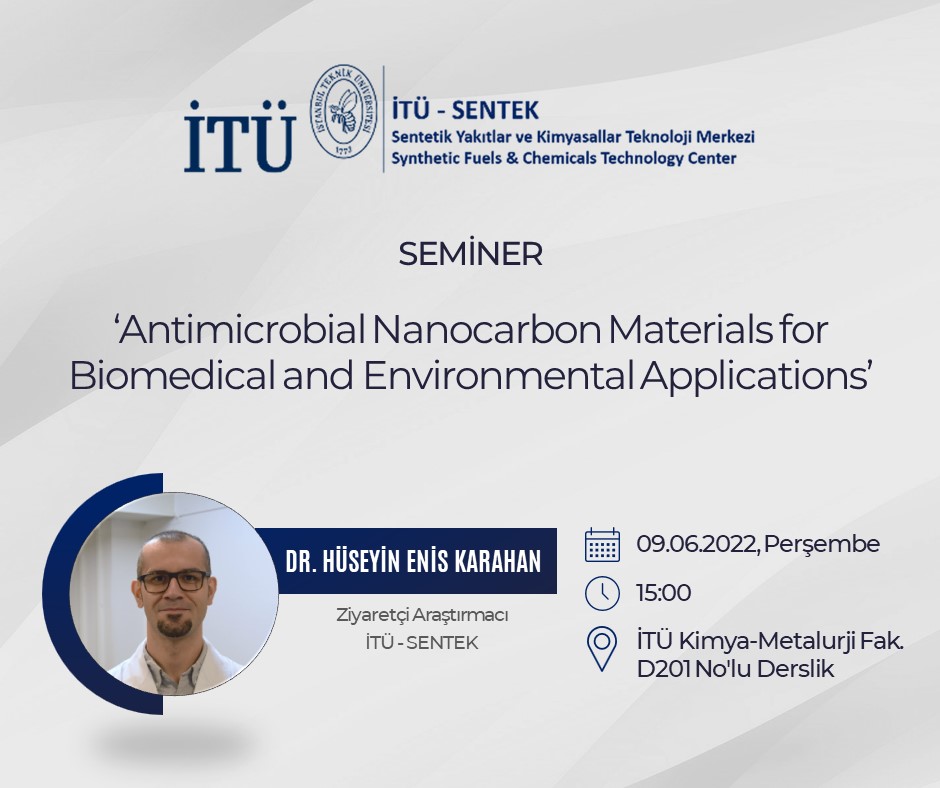İTÜ Sentetik Yakıtlar ve Kimyasallar Teknoloji Merkezi’nde TÜBİTAK BİDEB-2221 programı desteği ile misafir araştırmacı olarak ortak çalışmalarda bulunan Dr. Hüseyin Enis KARAHAN, 09 Haziran 2022 Perşembe günü saat 15:00'te Kimya Metalurji Fakültesi D-201 nolu derslikte "Antimicrobial Nanocarbon Materials for Biomedical and Environmental Applications" başlıklı bir seminer verecektir.
Title: Antimicrobial Nanocarbon Materials for Biomedical and Environmental Applications
Speaker: Dr. H. Enis Karahan
e-mail: karahanhe@itu.edu.tr
Over the last two decades, carbon-based nanomaterials (nanocarbons) have emerged as an alternative family of antimicrobial agents potentially useful for biomedical and environmental applications. Particularly graphene-family materials (GFMs) have attracted vast attention with their promise to fight against the increasing threat of antibiotics- and metal-resistant bacterial pathogens. However, despite intense efforts, GFMs are still in their infancy for realistic application scenarios. When we realized this picture a couple of years back, I argued that one major reason behind it is the disproportionate exploration of materials properties (e.g., particle dimensions, surface charge), leaving other aspects virtually untouched. Then, to fill this gap, we first systematically investigated the roles of abiotic parameters on the antibacterial activity of graphene oxide (GO).1 We discovered that GO is more effective when bacterial cells are exposed to osmotic stress by reducing environmental salinity or introducing a block copolymeric stabilizer at a high concentration.1 Subsequently, we unearthed the crucial impact of cellular physiology on the antibacterial activity of GO nanosheets.2 We found that physiologically matured bacterial cells are more resistant to GO and GO-polymer dispersions.2,3 These results allowed us to develop structure-activity relationships that describe the antimicrobial activity of GFMs.4 And notably, partly built on the know-how generated in these fundamental studies, we also fabricated GFM- based gravity filters for point-of-use disinfection of contaminated water.5 In this talk, I will introduce the background and key findings of these efforts, discussing their broader implications on biomedical6 and environmental7 applications. Plus, I will also give a glimpse of our more recent efforts, including the utilization of biomass-derived nanocarbons8 for related biomedical and environmental applications.
1. H.E. Karahan et al., Small, 2016, 12, 951.
2. H.E. Karahan et al., Nanoscale, 2016, 8, 17181.
3. H.E. Karahan et al., IEEE NANO 2017, 303.
4. H.E. Karahan et al., Biomater. Sci., 2018, 6, 766.
5. L. Wang et al., J. Colloid Interface Sci., 2019, 535, 149.
6. H.E. Karahan et al., Adv. Healthc. Mater., 2018, 7, e1701406.
7. L. Wang et al., Nanoscale, 2019, 11, 9819.
8. H.E. Karahan et al., 2020, J. Mater. Chem. B, 2020, 8, 9668.
Dr. Karahan completed his undergraduate studies at ITU in Chemical Engineering (principal major) and Molecular Biology and Genetics departments (within the double major program), and his master’s and doctoral studies in the Materials Science and Engineering program of Koç University and Bioengineering program of Nanyang Technology University, respectively. He started his post-doctoral research at Singapore Membrane Technology Center and The University of Sydney and later continued at the Institute for Integrated Cell-Material Sciences (iCeMS) under Kyoto University. Since March 2022, he has been serving as a visiting scientist at ITU-SENTEK with the support of TUBITAK (BIDED 2221 program). He has received numerous international recognitions, including the SINGA Scholarship, the Brian Kelly Award, CARBON Journal Prize, JSPS Fellowship, and Fulbright Scholarship. Currently, he is a member of the editorial boards of CARBON and COATINGS journals. His research interests include molecular self-assembly, functional surface coatings, nanostructured antimicrobial materials, and advanced carbon-based membranes.
